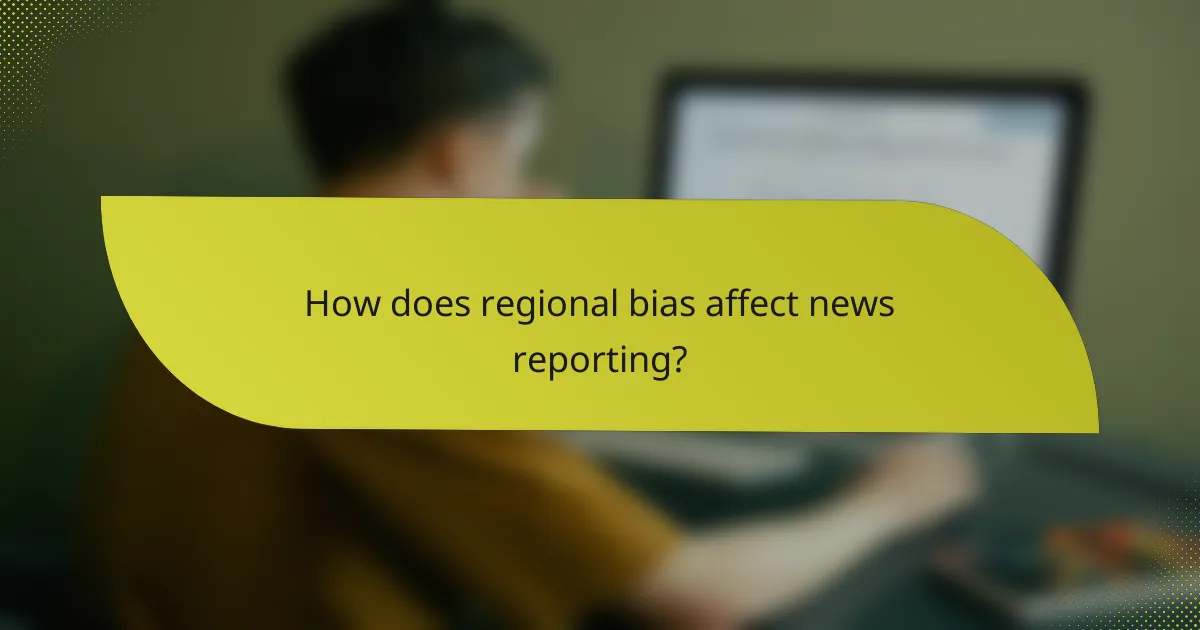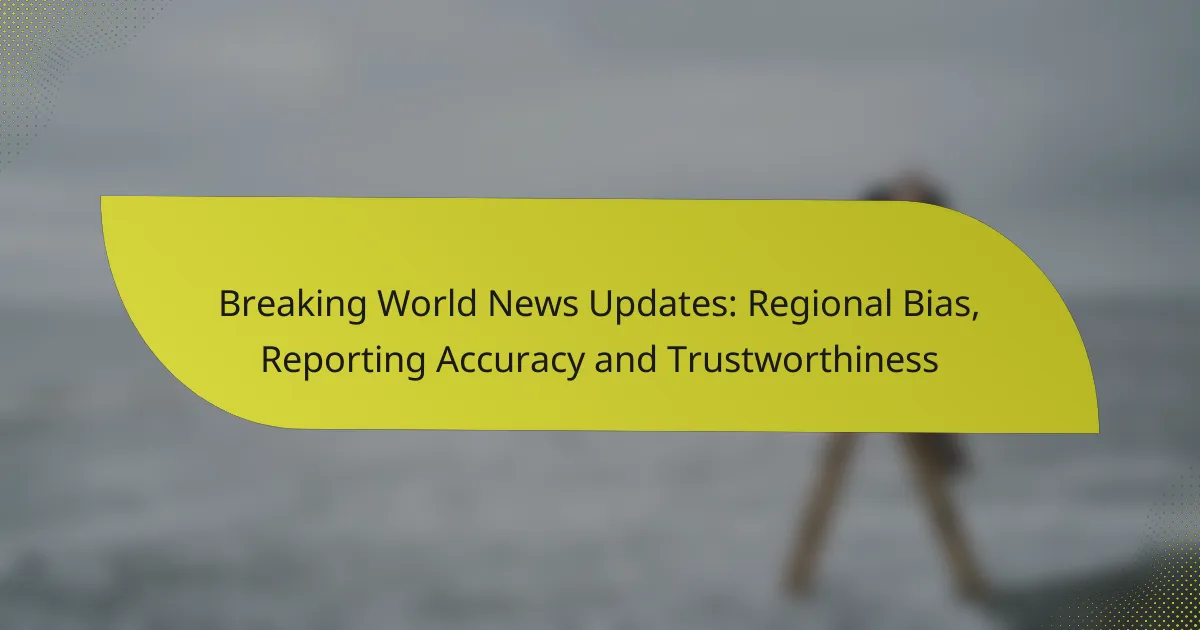In today’s fast-paced information landscape, breaking world news updates are often influenced by regional bias, which can distort the selection and framing of stories. This bias not only shapes public perception but also raises concerns about the accuracy and trustworthiness of reporting. To foster reliable news coverage, it is essential for media outlets to prioritize rigorous fact-checking and transparency, allowing audiences to critically assess the credibility of the information they consume.

How does regional bias affect news reporting?
Regional bias significantly influences news reporting by shaping the selection, framing, and interpretation of stories based on local interests and perspectives. This bias can lead to skewed narratives that prioritize certain viewpoints while neglecting others, ultimately affecting public trust in the media.
Influence of local media ownership
Local media ownership often dictates the editorial stance of news outlets, as owners may have specific political or economic interests. For instance, a newspaper owned by a large corporation might downplay negative news about its business practices while highlighting issues that favor its agenda. This can create a distorted view of reality for the audience.
Additionally, local ownership can lead to a focus on regional issues over national or international matters, which may limit the audience’s understanding of broader contexts. Consumers should be aware of who owns their local news sources and consider how that might influence reporting.
Impact of cultural perspectives
Cultural perspectives play a crucial role in shaping news narratives, as journalists often interpret events through the lens of their own backgrounds. This can lead to varying portrayals of the same event in different regions, reflecting local values and societal norms. For example, coverage of protests may be framed as a fight for justice in one area and as a disturbance in another, depending on cultural attitudes.
Moreover, cultural biases can affect language use, imagery, and even the selection of sources, which may reinforce stereotypes or marginalize certain groups. Audiences should critically evaluate how cultural context influences the news they consume.
Examples of biased reporting in major regions
In the United States, media outlets may exhibit regional bias by emphasizing local political issues, such as gun control or immigration, in ways that align with their audience’s beliefs. For instance, conservative outlets might focus on crime rates to argue against immigration, while liberal outlets may highlight the contributions of immigrants to society.
In Europe, reporting on the refugee crisis has varied significantly between countries. Nations like Germany may present a more humanitarian perspective, while others, such as Hungary, may portray refugees as a threat to national security. These differing narratives can influence public opinion and policy decisions across the continent.

What are the best practices for ensuring reporting accuracy?
Ensuring reporting accuracy involves implementing systematic approaches that prioritize truthfulness and reliability in news coverage. Key practices include rigorous fact-checking, sourcing information from credible outlets, and providing ongoing training for journalists to uphold high standards of accuracy.
Fact-checking protocols
Fact-checking protocols are essential for verifying the information before publication. Journalists should cross-reference claims with multiple credible sources and utilize established fact-checking organizations to confirm accuracy. Implementing a checklist for fact-checking can help streamline this process.
Common steps in a fact-checking protocol include identifying the claim, sourcing evidence, and documenting the verification process. This not only enhances the credibility of the report but also builds trust with the audience.
Use of reliable sources
Using reliable sources is crucial for maintaining reporting accuracy. Journalists should prioritize information from established news organizations, academic institutions, and verified experts in relevant fields. This helps ensure that the information presented is both accurate and trustworthy.
It’s important to evaluate sources based on their reputation, expertise, and potential biases. A good practice is to consult primary sources whenever possible, as they provide direct evidence and reduce the risk of misinterpretation.
Training for journalists on accuracy
Training for journalists on accuracy is vital for fostering a culture of responsibility in reporting. Regular workshops and seminars can equip journalists with the skills needed to identify misinformation and adhere to ethical standards in journalism.
Training programs should cover topics such as media literacy, the importance of fact-checking, and understanding the implications of spreading false information. Encouraging a commitment to accuracy can significantly enhance the overall quality of news reporting.

How can audiences assess the trustworthiness of news sources?
Audiences can assess the trustworthiness of news sources by evaluating their reputation, editorial standards, and transparency in reporting. This involves looking for established organizations, understanding their guidelines, and checking how openly they share their processes and corrections.
Identifying reputable news organizations
Reputable news organizations often have a long-standing history and are recognized for their journalistic integrity. Look for outlets that are members of professional associations, such as the Associated Press or Reuters, which adhere to strict ethical guidelines.
Check for awards and recognitions, as these can indicate a commitment to quality journalism. Additionally, consider the outlet’s funding sources; those that are publicly funded or have diverse revenue streams may be less biased than those reliant on advertising alone.
Understanding editorial standards
Editorial standards refer to the guidelines that govern how news is reported and presented. Trustworthy organizations typically have clear policies on fact-checking, sourcing, and corrections, which help ensure accuracy and accountability.
Familiarize yourself with the specific standards of a news outlet. For instance, many reputable sources will openly publish their editorial guidelines on their websites, allowing readers to understand their commitment to truth and fairness.
Evaluating transparency in reporting
Transparency in reporting involves how openly a news organization shares its processes, sources, and any potential conflicts of interest. Trustworthy sources often provide detailed information about their journalists, including their qualifications and backgrounds.
Look for news outlets that disclose their sources, especially when reporting on sensitive issues. A transparent organization will also correct errors promptly and visibly, showing a commitment to maintaining trust with its audience.

What role do social media platforms play in news dissemination?
Social media platforms are crucial in how news is shared and consumed, often acting as primary sources for breaking news. They enable rapid dissemination of information but also raise concerns about accuracy and trustworthiness.
Algorithms affecting news visibility
Algorithms on social media platforms determine which news stories appear in users’ feeds, significantly impacting visibility. These algorithms often prioritize content based on engagement metrics, such as likes and shares, rather than factual accuracy.
This can lead to a skewed perception of news, where sensational or controversial stories gain more traction than balanced reporting. Users may inadvertently receive a narrow view of events, shaped by their interactions and preferences.
Spread of misinformation
The rapid sharing capabilities of social media can facilitate the spread of misinformation, making it challenging to discern credible news sources. False information can circulate widely before being corrected, sometimes leading to real-world consequences.
Users should be cautious and verify news from multiple reputable sources before accepting it as true. Fact-checking websites and tools can help mitigate the risks associated with misinformation.
Examples of social media impact on news trust
Social media has both bolstered and undermined trust in news. For instance, during major events like elections or natural disasters, platforms can amplify reliable reporting but also propagate unverified claims that erode public confidence.
Recent studies indicate that trust in news varies significantly across different platforms, with users often perceiving traditional media as more reliable than social media sources. Engaging with diverse news outlets and critically evaluating content can help restore trust in news dissemination.

How can news organizations combat misinformation?
News organizations can combat misinformation by adopting proactive strategies that enhance reporting accuracy and build public trust. These strategies include educational initiatives, partnerships with fact-checkers, and leveraging technology to identify false information.
Implementing educational campaigns
Educational campaigns can empower audiences to critically evaluate news sources and discern credible information from misinformation. These initiatives can take the form of workshops, online courses, or community outreach programs that teach media literacy skills.
For example, a news organization might host a series of webinars aimed at helping viewers understand how to identify biased reporting or verify facts. By fostering a more informed public, these campaigns can reduce the spread of false information.
Collaborating with fact-checking organizations
Collaborating with established fact-checking organizations can enhance the credibility of news reports. These partnerships allow news outlets to verify claims before publication, ensuring that information is accurate and trustworthy.
For instance, a news organization could work with a fact-checking group to review statements made by public figures during election seasons. This collaboration not only improves reporting accuracy but also signals to audiences that the organization values truthfulness.
Utilizing technology for misinformation detection
Utilizing technology, such as artificial intelligence and machine learning, can significantly aid in the detection of misinformation. These tools can analyze large volumes of data to identify patterns indicative of false narratives or misleading content.
For example, news organizations can deploy algorithms that flag potentially false information on social media platforms, allowing for quicker responses. However, it is essential to balance technology use with human oversight to avoid misidentifying legitimate content as misinformation.

What are the emerging trends in global news reporting?
Emerging trends in global news reporting include the rise of citizen journalism and an increased focus on multimedia storytelling. These trends reflect a shift towards more inclusive and engaging news coverage, driven by technological advancements and changing audience preferences.
Rise of citizen journalism
Citizen journalism refers to the practice where ordinary individuals report news events, often using smartphones and social media platforms. This trend has gained momentum due to the accessibility of technology, allowing anyone to share information quickly and widely.
While citizen journalism can enhance coverage by providing diverse perspectives, it also raises concerns about accuracy and reliability. Consumers should verify information from citizen sources against established news outlets to ensure trustworthiness.
Increased focus on multimedia storytelling
Multimedia storytelling combines text, images, videos, and interactive elements to create a richer news experience. This approach caters to various audience preferences, making news more engaging and easier to digest.
News organizations are increasingly investing in multimedia content to capture attention and convey complex stories effectively. For instance, a single news article may include a video summary, infographics, and interactive maps, enhancing the overall understanding of the topic.
